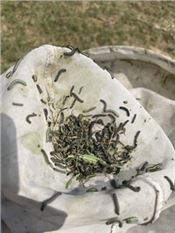Fall Armyworm Running Amok (Pastures, Soybean, Lawns, And More)

Picture courtesy of Jake Mallard
DR. SCOTT STEWART
JACKSON, TENN.
The fall armyworm outbreak of 2021 is going to be one to remember. My colleague, Dr. Gus Lorenz in Arkansas called it “epic”. We knew something was different this year when another colleague in Texas, Dr.
David Kerns, gave us a warning over a month ago. So what’s different? First, the fall armyworm flight is several weeks early, second, larval infestations have been unusually high, and third, for whatever reason, control with pyrethroid insecticides has been unusually poor (ranging from sometimes acceptable to a complete failure).
So far, West Tennessee appears worst affected, but this will probably change as the armyworms continue their ‘march’. It almost goes without saying that bermudagrass pastures are at high risk. It’s not every field, but some double-cropped soybean fields are heavily infested, and it’s even worse where volunteer wheat or other grasses were present that attracted the moths. Even bermudagrass lawns are being infested, and homeowners and landscapers need to be especially alert on newly sodded or seeded lawns (fall armyworms really love the tender new growth). What little sorghum that is out there, including sorghum Sudangrass, is also at risk.
So what’s the game plan?
In pastures, refer to the 2021 Insect Control Recommendations at https://extension.tennessee.edu/publications/Documents/PB1768.pdf (pages 61-62) for insecticide recommendations, but avoid using the pyrethroid insecticide like Baythroid XL, Mustang Max, and Warrior.
The alternatives will be more expensive but you may make up the differences in making fewer applications in the long run.
Similar advice in soybean. Avoid using pyrethroid insecticides, and if you do use them, tank mix with a minimum of 0.5 lb of Acephate and check back within 2-3 days to make sure it worked. A more trustworthy suggestion is to use products containing chlorantraniliprole (e.g., Besiege, Prevathon, Vantacor, Elevest), or Intrepid, Intrepid Edge, or Blackhawk. For the most part, you should be able to use the lower end of the recommended label rates. The defoliation threshold for soybean prior to bloom is 30-35 percent, but don’t wait on this to happen if large numbers of armyworms are present. Catching 10-15 per 25 sweeps on small soybeans should catch you attention, especially if you already are finding 15-20 percent defoliation. If you are seeing a broad mix of small and larger larvae, that’s a clue that pressure is continuing. The point is, it will require a little judgement to make treatment decisions.
For sorghum, follow the recommendation at https://guide.utcrops.com/sorghum/ , but again, avoid products containing only a pyrethroid insecticide.
Options are more limited for homeowners trying to control armyworms in their lawns, refer to the following article from Mississippi State University, http://extension.msstate.edu/publications/control-insect-pests-and-around-the-home-lawn ∆
DR. SCOTT STEWART: IPM Extension Specialist, University of Tennessee